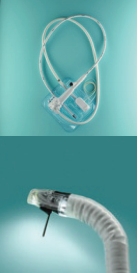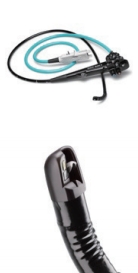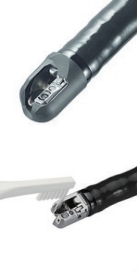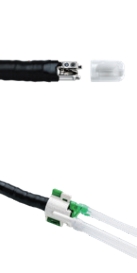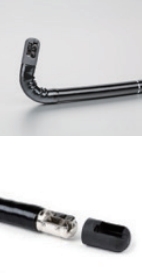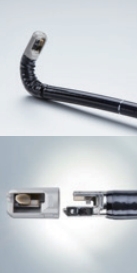INTRODUCTION
Gastrointestinal endoscopy involves the process of inserting an endoscope via patientsŌĆÖ oropharyngeal space where microbes reside, prompting the concern of spreading various infections. Due to the significant risk of transmitting pathogens between the individuals undergoing endoscopic procedure, high level disinfection (HLD) process of endoscopes is of utmost importance. To that end, careful endoscopy reprocessing protocols have been established to mitigate this adverse outcome. The bulk of these protocols however, focus on the disinfection process of forward-viewing endoscope such as gastroscope and colonoscope.
The duodenoscope is a side-viewing endoscope, where its camera and working channel exit point are located at the side of scope tip, rather than at its end. In addition, the presence of ŌĆ£elevatorŌĆØ to adjust the angle of accessory device approach further adds to the complexity of its construct, as well as its cleansing process. There are potential ŌĆ£blind spotsŌĆØ where collection of debris and bacterial flora can gather and serve as a source of microbial transmission. Thus, standard cleaning and disinfection methods may be insufficient for a duodenoscope. Due to its mechanical complexity and sensitive component, high-temperature sterilization is not feasible [1,2]. In recent years, carbapenem resistant Enterobacteriaceae (CRE) infection outbreak among the patients who underwent endoscopic retrograde cholangiopancreatography (ERCP) have been reported, further substantiating the concern [3-6]. Furthermore, another study linked the death of dozens to multidrug-resistant organisms after ERCP [7]. In this review, we discuss currently available technologies and innovative endeavors with duodenoscope design to mitigate this potentially life-threatening adverse outcome.
THE MAGNITUDE OF THE PROBLEM
A Dutch medical group first attributed the transmission of infection in patients who underwent ERCP to the newly distributed, fixed-cap style duodenoscope (TJF-Q180V; Olympus Corporation, Tokyo, Japan) in 2010 [8]. The transmission of Verona Integron-encoded Metallo-╬▓-lactamase (VIM)-2-producing Pseudomonas aeruginosa was attributed to the unresolved bioburden within duodenoscope. Subsequently, the Dutch Ministry of Health conceded that endoscopic procedures do not have sufficient evidence to prove the validity and safety of current reprocessing instructions [9]. Since then, a group of endoscopy manufacturers have issued two warnings to the European Endoscopy Center in 2013 and 2014. The warnings however were limited to the latest generation of duodenoscope at that time and potential inadequacy of its reprocessing process in infection prevention. In 2012, a series of US-based infections were reported in Massachusetts, New York, and Pennsylvania, raising similar concerns to the Dutch counterparts. In addition, most of the US-based cases were characterized by a unique antibiotic resistance pattern, based on in-vitro examination of the pathogens [10]. In the end, these findings forced three side-viewing duodenoscope manufacturers to concede a real concern with the duodenoscope as a vector of concomitant infections with contamination [11].
In 2018, 73 Dutch centers reported their findings of a nationwide cross-sectional study on the prevalence of bacterial contamination of reprocessed duodenoscopes [11]. The samplings were performed from duodenoscopes that had undergone reprocessing such as high level disinfection or drying in the storage cabinet. At least two duodenoscopes were chosen for each center, including the newest Olympus TJFQ180V if available in their endoscopic procedure sites. They evaluated AM20 (microbial growth with Ōēź 20 CFU/20 mL of any type of microorganism; ESGE guideline and Dutch De Stuurgroep Flexibele Endoscopen Reiniging en Desinfectie [SFERD] handbook) and microbes of gastrointestinal origin (MGO) (presence of microbial growth (Ōēź 1 CFU/20 mL) of gastrointestinal and/or oral microorganisms). Their findings showed AM20 contamination in 39% of patient-ready duodenoscope, and 15% of reprocessed/cleaned duodenoscopes harbored MGO, indicating the presence of organic residue of previously treated patients. In terms of prevalence, MGO detection was noted from cleansing brush (12%), protection cap (11%), air/water channel (5%), biopsy channel (3%), and suction channel (3%). The detection rate of MGO was highest in brush (10%), followed by biopsy protection cap (5%), forceps elevator (5%), biopsy channel (4%), suction channel (4%). Douglas et al. studied the effect of double-reprocessing high-level disinfection on a duodenoscope contamination [12]. They reported the contamination rates between 4.8-9.4 % through the 3 phase study, which was lower than the rate reported by Ross et al. which was 13.1% [10]. Several studies identified the presence of biofilm, in which bacterial pathogens can survive despite standard disinfection process, as the main culprit of these worrisome findings [8,13,14].
PATHOGENS AND CLINICAL IMPLICATION
Among the infectious bacteria, CRE, also known as ŌĆ£superbugŌĆØ, has recently garnered much concern. It was first reported in 2013 when the exposure to duodenoscope was identified as the culprit of transmission [4]. In this outbreak of 39 cases, 35 patients were exposed to duodenoscope in one hospital. In addition, New Delhi metallo-╬▓-lactamase (NDM)-producing Escherichia coli also was identified from a reprocessed duodenoscope. The clinical implication of CRE is significant in that its resistance to carbapenem, a broad-spectrum antibiotic with a robust treatment spectrum, renders medical community with limited treatment options. In Korea for example, CRE infection is designated as ŌĆślegal communicable diseaseŌĆÖ since 2010, and its outcomes are closely monitored with a designated surveillance system. In 2017, CRE was designated to infectious disease, Class III, requiring a mandatory surveillance system. As of 2020, CRE infection was elevated to Class II infectious disease in Korea. Specifically, Carbapenemase producing carbapenem-resistant Enterobacteriaceae is a type of CRE that produces enzymes to degrade a wide array of antibiotics, and also has the ability to transmit its resistance profile to other pathogens.
HLD defect rates are used as surrogate markers of scope related infection. One center recorded an HLD deficiency rate of 1.9% per year in 1500 consecutive cultures [10]. Another center that performed ethylene oxide sterilization after the outbreak of CRE infection showed positive culture rate in the 1.2% range over 18 months form 84 duodenoscopes in their monthly culture analysis [15]. During ERCP, CRE transmission after its use within contaminated duodenum(confirmed retrospectively) was 14.4% during biliary stenting. The inpatient status was identified as an independent risk factor (odds ratio 3.74, 95% confidence interval 1.15-12.12) for CRE infection. The diagnosis of cholangiocarcinoma was also associated with an increased risk CRE infection [16].
DISPOSABLE SINGLE USE DUODENOSCOPE
The argument for a single use duodenoscope is based on the validated findings of unsatisfactory level of disinfection of reprocessed duodenoscopes with currently available cleansing methods. At present, two broader options of disposable duodenoscope exist: Use of disposable pieces in currently available duodenoscopes, and the utilization of a single use duodenoscope that can be discarded after one-time use.
In April 2019, the US Food and Drug Administration (FDA) recommended that hospitals and endoscopy facilities should transition to innovative duodenoscope designs that include disposable components such as disposable endcaps or to fully disposable duodenoscopes when they become available. Although it is not a part of gastrointestinal endoscopy, a fiberoptic endoscope has also been developed and used in other specialties. These are single-use bronchoscope (aScope; Ambu A/S, Ballerup, Denmark) and single-use digital flexible ureteroscope (LithoVue; Boston Scientific, Marlborough, MA, USA). Both disposable endoscopes reported comparable performance and clinical effects with conventional fiberoptic endoscopes [17,18]. In addition, there are reports that they have the effect of reducing overall medical costs in certain circumstances [19,20]. In December 2019, FDA cleared first fully disposable duodenoscope, eliminating the potential for transmission of pathogens from ineffective reprocessing. To date, the FDA has cleared six duodenoscopes with disposable components that facilitate reprocessing (Table 1).
Muthusamy et al. performed a multi-center clinical evaluation on a single-use duodenoscope for ERCP in 6 academic medical centers with 7 expert endoscopists in US [21]. They used the EXALT Model D single-use duodenoscope (Boston Scientific, Marlborough, MA, USA). Of 60 cases of ERCP with the EXALT model, 58 (96.7%) cases were successfully completed with the use of the single use duodenoscope, while 2 cases (3.3%) required transition to the traditional reusable duodenoscope after the attempts with single-use duodenoscope were not successful. The first case of crossover occurred during dilation of high-grade biliary stricture of a peripheral left-sided intrahepatic bile duct with primary sclerosing cholangitis history and reported to be associated with the duodenoscope being hard to torque and maneuver, possibly due to shaft stiffness. In the second crossover case, initial cannulation with both single-use duodenoscope and reusable duodenoscope (TJF-Q180V; Olympus Corporation, Tokyo, Japan) were unsuccessful through the native papilla. The distribution of procedural complexity - based on American Society for Gastrointestinal Endoscopy guideline - was as followed: 7 patients (11.7%) with complexity grade 1, 26 patients (43.3%) with grade 2, 26 patients (43.3%) with grade 3, and a patient (1.7%) with grade 4 (most complex). Two crossover cases were grade 2 and grade 3 [22]. Median overall satisfaction with the disposable duodenoscope was 9 when evaluated on Likert scale of 1 (unsatisfied) to 10 (very satisfied).
Ross et al. [23] performed a comparative study between a single use duodenoscope and 3 models of reusable duodenoscopes for ERCP; EXALT Model D, TJF-Q180V reusable duodenoscope, ED-3470TK reusable duodenoscope (Pentax Corporation, Tokyo, Japan), and ED-530XT reusable duodenoscope (Fujifilm Holdings Corporation, Tokyo, Japan). They conducted a comparative bench stimulation study by 6 expert endoscopists. They rated various aspects of these scopes including navigational ease, mechanical control, and image quality on a scale of 1 (worst) to 10 (best). The overall performance ratings by tasks are similar (median, 8.0-10.0). Navigation/maneuverability ratings were lower for the disposable duodenoscope than for the three reusable duodenoscopes (median, 8.0, 10.0, 9.0, and 9.0, respectively; p<0.01). Ratings tip control was similar for all duodenoscopes (median, 9.0-10.0; p=0.77). Image quality for 1 reusable duodenoscope (ED-3470TK) was rated lower than that of disposable and reusable duodenoscope one of the other two (median, respectively, 8.0, 9.0, 9.0 and 9.0; p<0.01). Thus, the median image quality score of single use duodenoscope was one point lower (score of 4) than the score expected with reusable duodenoscope (the score of 5). Similarly, the median score on the ŌĆ£elevator functionŌĆØ of single use duodenoscope was rated as 4 out of 5. The clinical significance however of these scores, is not clear.
CURRENT BARRIERS AND FUTURE
The cost remains as one the biggest obstacles in the dissemination of single use duodenoscope. Bang et al. reported that each centers have different opinions for the cost of disposable duodenoscopes, as the cost per procedure depends on the number of cases performed with each scope [24]. Using activity-based costs and financial models, the cost per case for the institutions performing at the 25th percentile of ERCP procedural volume in US (less than 50 cases per year), the cost per procedure ranged from $1,318 to $2,068. For the institutions operating at the 75th percentile of procedural volume (between 125 and 150 cases per year), the price was ranged from $797 to $1,547, based on the infection rates of 0.4% to 1% from published literature [11,16,25]. The study set the lifecycle (longevity) of duodenoscope at 3 years and with cost of an individual duodenoscope at $35,000 ($11,667/year), and annual maintenance and repair costs of $1,451 per scope. To obtain the overall cost of reusable duodenoscope, they added annual scope washer maintenance costs ($8,000), cleaning supplies ($10,424), labor costs ($60,230). To account for cost attributable to adverse outcome of procedure related infection, the study group also added the treatment of cholangitis costs ($125,000 per case, which included 2-day intensive care unit stay). Assuming that each reusable duodenoscope is used approximately 200 times per year, the substitution with single use duodenoscope would incur a cost of $367,200 ($612 per procedure) over 3-year period. It is important to note that their calculation is based on high-volume endoscopy centers, and the additional cost of substitution to a single use duodenoscope may be even more significant for the centers with lower volume.
In addition, no manufacturers of single use duodenoscope can meet the demand of complete replacement of reusable duodenoscope as the manufacturing capability cannot simply keep up with the total number of ERCP procedure being performed. Thus, it is critical to identify the patient groups who may benefit the most with the use of single duodenoscope, such as immunocompromised patients and immuno-suppressed transplant patients. The experts, in collaboration with the manufacturers are currently preparing a position statement regarding its ethical and justifiable allocation.
Given the significant financial burden of single use duodenoscope, alternative methods, such as disposable cap, mounted at the tip of duodenoscope, is also being considered. The details of this modality are not within the scope of this review. Suffice to say however, that if proven equivalent to single use duodenoscope in terms of its infection prevention rate, this method may present a more economical alternative to single use duodenoscope. It is however unlikely to be superior to duodenoscope given the fact that the duodenoscope itself is being inserted to patientsŌĆÖ gastrointestinal lumen and will be reused in others once the sterilization process takes place.
CONCLUSIONS
Considering the transmission of infectious microorganisms reported in recent years, the use of a disposable duodenoscope is not a matter of choice. However, there is a need for buffer measures to suppress excessive rise in treatment costs. It can be used by small volume institutions that do not want to invest in capital equipment and it is useful when using at operating room or emergency room in an emergency situation. In addition, it can be used to stent placement in patients with cholangiocarcinoma or in in-patients with increased risk of transmission of their own infection [16]. The complete disposable duodenoscope released so far is a product of two companies. In the near future, the use of disposable duodenoscope may become more popular due to problems such as the spread of more dangerous infectious microorganisms, an increase in labor costs, price reduction due to mass production and the increased cost of maintaining facilities. However, prior to its generalized adoption to current practice, some adjustments are still needed. After the use for example, proper methods of its collection, safe disassembly and redistribution of its components for potential recycling must be mapped out. As it stands, healthcare institutions determined to use this technology is also subjected to the mercy of the supply and distribution channel (pre and post use) of the manufacturer. Although unclear, this may cause additional financial burden to the end-user, namely the healthcare institutions.
Lastly, given the current state of production capability and environmental consideration, the clinicians who would be at the forefront of its use must formulate and prioritize proper indication for the device. This will require creation of guidelines and recommendations from respective gastrointestinal endoscopic societies. At present, the population with compromised immunological functions such as those with organ transplantation, active malignancy and acquired immunocompromised state ought to be considered appropriate for its use. Further studies are required to delineate clinical benefits in the aforementioned populations.




